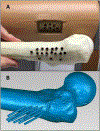An Extensible Orthopaedic Wire Navigation Simulation Platform
- PMID: 31379985
- PMCID: PMC6677394
- DOI: 10.1115/1.4043461
An Extensible Orthopaedic Wire Navigation Simulation Platform
Abstract
The demand for simulation-based skills training in orthopaedics is steadily growing. Wire navigation, or the ability to use 2D images to place an implant through a specified path in bone, is an area of training that has been difficult to simulate given its reliance on radiation based fluoroscopy. Our group previously presented on the development of a wire navigation simulator for a hip fracture module. In this paper, we present a new methodology for extending the simulator to other surgical applications of wire navigation. As an example, this paper focuses on the development of an iliosacral wire navigation simulator. We define three criteria that must be met to adapt the underlying technology to new areas of wire navigation; surgical working volume, system precision, and tactile feedback. The hypothesis being that techniques which fall within the surgical working volume of the simulator, demand a precision less than or equal to what the simulator can provide, and that require the tactile feedback offered through simulated bone can be adopted into the wire navigation module and accepted as a valid simulator for the surgeons using it. Using these design parameters, the simulator was successfully configured to simulate the task of drilling a wire for an iliosacral screw. Residents at the University of Iowa successfully used this new module with minimal technical errors during use.
Figures









Similar articles
-
Establishing Construct Validity of a Novel Simulator for Guide Wire Navigation in Antegrade Femoral Intramedullary Nailing.Iowa Orthop J. 2023;43(1):31-35. Iowa Orthop J. 2023. PMID: 37383869 Free PMC article.
-
Surgical Skill Can be Objectively Measured From Fluoroscopic Images Using a Novel Image-based Decision Error Analysis (IDEA) Score.Clin Orthop Relat Res. 2021 Jun 1;479(6):1386-1394. doi: 10.1097/CORR.0000000000001623. Clin Orthop Relat Res. 2021. PMID: 33399401 Free PMC article.
-
Do Skills Acquired from Training with a Wire Navigation Simulator Transfer to a Mock Operating Room Environment?Clin Orthop Relat Res. 2019 Oct;477(10):2189-2198. doi: 10.1097/CORR.0000000000000799. Clin Orthop Relat Res. 2019. PMID: 31135546 Free PMC article.
-
A Dedicated Simulator Training Curriculum Improves Resident Performance in Surgical Management of Pediatric Supracondylar Humerus Fractures.JB JS Open Access. 2023 Sep 11;8(3):e23.00031. doi: 10.2106/JBJS.OA.23.00031. eCollection 2023 Jul-Sep. JB JS Open Access. 2023. PMID: 37701678 Free PMC article. Review.
-
Clinical Application of Navigation in the Surgical Treatment of a Pelvic Ring Injury and Acetabular Fracture.Adv Exp Med Biol. 2018;1093:289-305. doi: 10.1007/978-981-13-1396-7_22. Adv Exp Med Biol. 2018. PMID: 30306489 Review.
Cited by
-
Establishing Construct Validity of a Novel Simulator for Guide Wire Navigation in Antegrade Femoral Intramedullary Nailing.Iowa Orthop J. 2023;43(1):31-35. Iowa Orthop J. 2023. PMID: 37383869 Free PMC article.
-
A Vision for Using Simulation & Virtual Coaching to Improve the Community Practice of Orthopedic Trauma Surgery.Iowa Orthop J. 2020;40(1):25-34. Iowa Orthop J. 2020. PMID: 32742205 Free PMC article.
-
DESIGN OF A PERCUTANEOUS ARTICULAR FRACTURE REDUCTION SIMULATOR.Proc Des Med Devices Conf. 2018 Apr;2018:V001T03A008. doi: 10.1115/DMD2018-6852. Proc Des Med Devices Conf. 2018. PMID: 31214298 Free PMC article. No abstract available.
References
-
- ACGME Highlights Its Standards on Resident Duty Hours. Available from: http://www.acgme.org/acgmeweb/tabid/363/Publications/Papers/PositionPape.... Accessed 5/20/2018
-
- ACGME Program Requirements for Graduate Medical Education in Orthopaedic Surgery. https://www.acgme.org/Portals/0/PFAssets/ProgramRequirements/260_orthopa.... Accessed 5/20/2018
-
- Ferguson PC, Kraemer W, Nousiainen M, Safir O, Sonnadara R, Alman B, Reznick R. Three-Year experience with an innovative, modular competency-based curriculum for orthopaedic training. J Bone Joint Surg Am. 2013. November 95 (21)e166. - PubMed
-
- Khanduja V, Lawrence JE, and Audenaert E, Testing the Construct Validity of a Virtual Reality Hip Arthroscopy Simulator. Arthroscopy, 2017. 33(3): p. 566–571. - PubMed
-
- Lopez G, et al., Construct Validity for a Cost-effective Arthroscopic Surgery Simulator for Resident Education. Journal of the American Academy of Orthopaedic Surgeons, 2016. 24(12): p. 886–894. - PubMed
Grants and funding
LinkOut - more resources
Full Text Sources
Other Literature Sources
Research Materials
Miscellaneous
